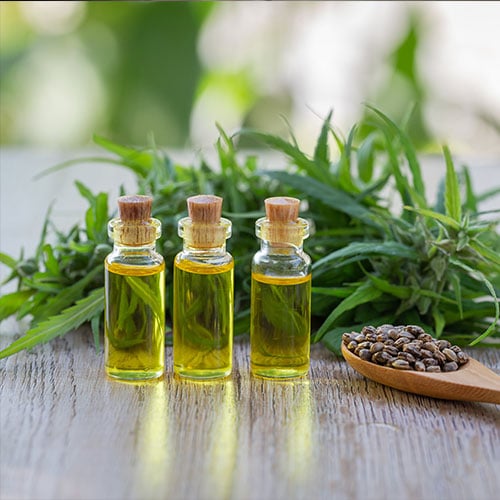
There’s more to exceptional marijuana than THC alone. The cannabis plant contains hundreds of compounds that add to its character and effects. Every marijuana strain contains different levels and ratios of these compounds, hence why strains can smell, taste, and feel so different.
The idea that multiple compounds contribute to the smell and taste of marijuana is not controversial. However, not everyone accepts the idea that numerous compounds are responsible for the effects of marijuana. People tend to be particularly divided on whether or not multiple compounds work together to create the effects of marijuana.
The idea that cannabis compounds work together synergistically to create the effects of cannabis is called the entourage effect. The entourage effect theory has been hotly debated in the scientific community in years past, but there’s growing evidence that at least two of the compounds in marijuana—THC and CBD—do have a synergistic effect. So, does that mean the entourage effect is real? And how, exactly, do CBD and THC work together? Find out below as we go over everything you need to know about the entourage effect.
The Origins of the Entourage Effect
The term “entourage effect” dates back to a 1999 paper written by chemists Raphael Mechoulam and Shimon Ben-Shabat. In their paper, the two scientists theorized that the compounds in cannabis all work together to create a therapeutic effect. They called this proposed mechanism “an entourage effect.” The entourage effect theory was contrary to the more popular theory of the time, which was that THC alone was primarily responsible for the effects of marijuana.
There are hundreds of compounds in the cannabis plant, including:
- Over 120 cannabinoids, including:
- Tetrahydrocannabinol (THC), cannabidiol (CBD), cannabigerol (CBG), cannabichromene (CBC), tetrahydrocannabivarin (THCV), cannabidivarin (CBDV), cannabinol (CBN)
- Over 150 terpenes, including:
- Myrcene, limonene, linalool, caryophyllene, alpha-pinene, beta-pinene, alpha-bisabolol, eucalyptol, borneol
- Over 20 flavonoids, including:
- Quercetin, catechin, orientin, silymarin, kaempferol
- Fatty acids
Mechoulam and Ben-Shabat theorized that all of these compounds may play a role in the effects of cannabis, but they believed that fatty acids were particularly important in enhancing an entourage effect. They proposed that fatty acids enhanced cannabinoid activity by allowing cannabinoids to bind better with the CB1 and CB2 receptors in the body’s endocannabinoid system. Their paper suggested that these fatty acids not only enhanced the activity of the phytocannabinoids found in cannabis, but also the activity of the body’s natural endocannabinoids.
Modern Entourage Effect Theories
The two most notable updates to the entourage effect theory come from the following research papers:
- Synergy research: Approaching a new generation of phytopharmaceuticals, written by Hildebert Wagner and Gudrun Ulrich-Merzenich in 2009
- Taming THC: potential cannabis synergy and phytocannabinoid-terpenoid entourage effects, written by Ethan Russo and in 2011
One of these focuses on how the entourage effect may work, while the other theorizes that two types of cannabinoid compounds are primarily responsible for the entourage effect
How the Entourage Effect Works
In their 2009 paper, Wagner and Ulrich-Merzenich expanded on the idea of the entourage effect by looking for ways in which cannabis compounds could interact. Their paper focuses on whole plant synergy possibilities, so they take all of the chemical compounds in cannabis into consideration.
Their paper outlines four abilities that could be made possible by an entourage effect:
- An ability to affect many different targets and areas of the body
- An ability to improve absorption of active ingredients
- An ability to overcome bacterial defense mechanisms
- An ability to minimize negative side effects
Cannabinoids, Terpenes, and the Entourage Effect
In his 2011 paper Taming THC, neurologist and pharmacologist Ethan Russo examines how two types of cannabis compounds, cannabinoids and terpenes, may have a synergistic effect. Both cannabinoids and terpenes, the aromatic compounds found in cannabis and the essential oils of many other plants, have a variety of studied benefits. In his paper, Russo details how these benefits could potentially be synergistic. For example, Russo notes that CBD and limonene have both shown promise in alleviating anxiety, so they may work well together to achieve that effect.
Russo’s paper didn’t prove the entourage effect theory, but it is notable for its pioneering ideas and its significant impact on future entourage effect research. In Taming THC, Russo gives ideas on potential synergistic interactions and proposes methods on how people can investigate entourage effects in future cannabis research experiments. Today, we’re finally starting to see the results of these types of experiments.
How CBD and THC Work Together

How CBD Helps THC
Studies have shown that CBD has a modulating effect on THC, the part of cannabis that is responsible for its psychoactive effects. CBD appears to enhance some of the beneficial effects of THC, such as its pain-relieving effects. Simultaneously, CBD appears to dull the potential negative side effects of THC, which can include anxiety, dizziness, and nausea.
Anecdotally speaking, many cannabis users report that taking CBD after consuming too much THC can be very helpful for easing negative side effects. This makes sense given that studies suggest CBD can lessen the negative side effects of THC.
CBD appears to change how the body processes THC, but more research is needed for us to fully understand how this occurs. Some studies suggest that CBD does this by changing how THC can interact with CB1 cannabinoid receptors in the brain. A notable 2019 study suggests that CBD may instead work by preventing overstimulation in a specific brain pathway, the extracellular signal-regulated kinase (ERK) pathway.
How THC Helps CBD
CBD has been heavily studied for its wide range of potential benefits. Studies suggest that CBD may have powerful anti-inflammatory effects and neuroprotective effects. Researchers are currently investigating using CBD as a treatment for conditions like anxiety, pain, depression, PTSD, opioid addiction, Alzheimer’s disease, multiple sclerosis, and arthritis. CBD has also been proven to have antiepileptic effects, as evidenced by the existence of Epidiolex, an FDA-approved epilepsy drug that features cannabidiol as its sole active ingredient.
CBD has a wide range of potential benefits when used on its own, but some studies have found that CBD may be even more effective when taken with THC. Even trace amounts of THC may improve the effectiveness of CBD products.
Because CBD may be more effective when taken with THC, people often recommend choosing full-spectrum CBD products instead of hemp or cannabis products that use CBD isolate. “Full-spectrum” means that the product contains the entire spectrum of compounds found within whole plant extract. For hemp-derived CBD products, that can include up to 0.3% THC, a trace amount that would not cause psychoactive effects. Marijuana-derived CBD products may have substantially more THC, making them better for those who aren’t adverse to psychoactive effects.
Is There an Ideal CBD to THC Ratio?
CBD and THC both seem to work better when used together. But is there an ideal CBD to THC ratio? As far as we know from current cannabis research, no, there’s no perfect ratio of CBD to THC. More research is needed on how these cannabinoids interact at different ratios.
Based on anecdotal evidence, we’d say it’s likely that there are different ideal CBD to THC ratios depending on a person’s desired effects and condition. For example, someone who is using medical cannabis to ease cancer-therapy-related nausea is probably going to have a different ideal CBD to THC ratio than someone who is using cannabis recreationally for its psychoactive effects.
Research on Terpene and Cannabinoid Interaction
Unfortunately, little research has been done on how cannabis terpenes interact with the body, whether used alone or when used in tandem with cannabinoids. There have been studies done on terpenes in general. For example, studies have found that the peppery terpene caryophyllene may have pain-relieving, anti-inflammatory, and antioxidant properties. Yet, most terpene studies do not source terpenes from cannabis, nor do they examine how terpenes interact with other cannabinoid compounds.
The existing studies on cannabis terpenes, specifically, have had mixed results. One 2020 study found no evidence that five common cannabis terpenes could bind to cannabinoid receptors, but another study from the same year found that three terpenes (including one that was also included in the other study) did activate CB1 receptors. A more recent 2021 study had promising results, finding that terpenes selectively enhanced cannabinoid activity in mice.
Final Thoughts on the Entourage Effect

So, is the entourage effect real? The research on CBD and THC is supportive of the entourage effect theory, so you could say that CBD and THC are an entourage of two. As far as other potential members of the entourage go, more research is needed. There’s still so much left to discover about the complex way cannabis compounds interact. While the entourage effect is starting to look more plausible than ever before, we’ll have to wait on more research to fully understand which compounds are in the entourage.



